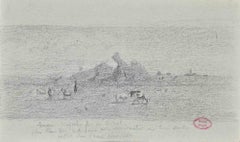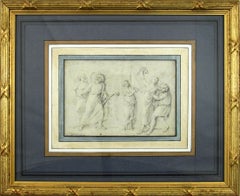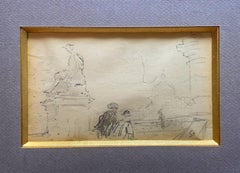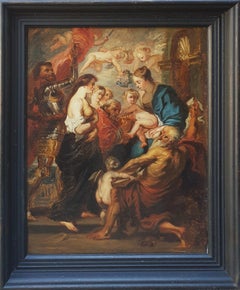Paul Huet Art
to
2
1
1
2
Overall Height
to
Overall Width
to
2
1
1
1
1
1
1
2
4
6,910
3,240
2,514
1,217
2
Artist: Paul Huet
The Maiden - Original Drawing by Paul Huet - 19th Century
By Paul Huet
Located in Roma, IT
The Maiden is an original Drawing in pencil realized in the 19th Century by Paul Huet (1803-1869).
With another drawing on the rear.
In good condition.
The artwork is depicted sk...
Category
19th Century Modern Paul Huet Art
Materials
Pencil
Landscape - Drawing by Paul Huet - 19th Century
By Paul Huet
Located in Roma, IT
Landscape is a Pencil Drawing realized by Paul Huet.
Good condition included a grey cardboard passpartout (32.5x50 cm).
Stamp signed on the lower right corner.
Paul Huet (3 October 1803 – 8 January 1869) was a French painter and printmaker born in Paris. He studied under Gros and Guerin. He met the English painter Richard Parkes Bonington in the studio of Gros, where he studied irregularly from 1819 to 1822. Bonington's example influenced Huet to reject neoclassicism and instead paint landscapes based on close observation of nature. The British landscape paintings exhibited in the Salon of 1824 were a revelation to Huet, who said of Constable's work: "It was the first time perhaps that one felt the freshness, that one saw a luxuriant, verdant nature, without blackness, crudity or mannerism."[4] Huet's subsequent work combined emulation of the English style with inspiration derived from Dutch and Flemish old masters such as Rubens, Jacob van Ruisdael...
Category
19th Century Modern Paul Huet Art
Materials
Pencil
Related Items
François-Édouard Picot (French 1786-1868) Greek Comedy Play 19th Century Drawing
By François-Édouard Picot
Located in Meinisberg, CH
François-Édouard Picot
(French, 1786 – 1868)
Ancient Greek Comedy Play
• Pencil Drawing on laid paper behind decorative matting, visible image, ca. 10.5 x 15.5 cm
• Modern Glased frame, ca. 27 x 33 cm
• Signed "Picot fecit" lower left
• As we photographed through glass, there are reflections in the images
Worldwide shipping is complimentary - There are no charges for handling & delivery
Here we have the somewhat unusual, yet typical subject matter François-Édouard Picot was interested in depicting. Shown is a scene from an ancient Greek comedy play. The previous owner has noted on the back, that this image was copied from an ancient Greek stone relief.
François-Édouard Picot was born on the 10th of October in 1786 in Paris, France. He studied with various masters and became well known for his historical and mythological subjects. In 1812 he won the second prize in the Prix de Rome competition and after that success, went on to exhibit at the Paris Salon, where in the year 1819 he won a first-class medal for his neoclassical L'Amour et Psyché, which today hangs in the Louvre in Paris. He regularly exhibited his work in the salon up to 1839. He taught several young great artists at his elitist studio and was known for accepting only very few students, which included William Bouguereau, Gustave Moreau, Cabanel and Paul Seignac...
Category
Early 19th Century Naturalistic Paul Huet Art
Materials
Laid Paper, Pencil
Free Shipping
H 10.63 in W 13 in D 1.19 in
Theophile Alexandre Steinlen (1859-1923) Men at the Pont du Carrousel, drawing
By Théophile Alexandre Steinlen
Located in Paris, FR
Theophile Alexandre Steinlen (1859-1923)
Men at the Pont du Carrousel,
Signed "St" on the lower right
pencil on paper
9 x 15 cm
framed : 24,5 x 30 cm
In good condition, slightly ye...
Category
1890s Impressionist Paul Huet Art
Materials
Carbon Pencil
Who needs a mammoth - Book illustration, Polish artist, Watercolor painting
By Joanna Rusinek
Located in Warsaw, PL
Illustration for book by Agnieszka Frączek 'Who needs a mammoth'
JOANNA RUSINEK
Printmaker, illustrator of children's books, author of press ill...
Category
2010s Contemporary Paul Huet Art
Materials
Paper, Watercolor, Pencil
Mon Colonel
By Auguste Chabaud
Located in London, GB
'Mon Colonel', pencil and crayon on paper, by noted French artist, Auguste Chabaud (circa 1914-1918). A delightfully simple drawing of a French Army colonel in profile along with clo...
Category
1910s Modern Paul Huet Art
Materials
Paper, Crayon, Pencil
French Modern Drawing by Jean Hélion - Veil Homme
By Jean Hélion
Located in Paris, IDF
Veil Homme
1947
drawing
26,9 x 21 cm
Registered on the catalogue raisonné with inventory number : N°0252 cat. B
sold without frame
about Jean Hélion (April 21, 1904 – October 27, 19...
Category
1960s Modern Paul Huet Art
Materials
Pencil, Paper
Auguste Mayer (1805-1890) A seascape with a boat, signed drawing
Located in Paris, FR
Auguste Mayer (1803-1890
A seascape with a boat
signed with the initials on the lower left
Pencil and heightenings of white gouache on paper
17.5 x 26 cm
In fairly good condition, ma...
Category
1860s Romantic Paul Huet Art
Materials
Carbon Pencil, Gouache
Jules Noel (1810-1881) Landscape with a fisherman, signed drawing
By Jules Noel
Located in Paris, FR
Jules Noel (1810-1881)
Landscape with a fisherman,
Signed lower right
Pencil on paper
27.8 x 44 cm
Framed under glass : 43 x 59.5 cm
We find in this drawing everything that makes...
Category
1860s Romantic Paul Huet Art
Materials
Pencil
1940s Charcoal and Pencil Portrait of a Man
Located in Arp, TX
Artist Unknown
"Tie and Glasses"
c. 1940s
Charcoal and pencil on paper
13.5"x17" image 15.5"x19" paper unframed $250
Unsigned
*Listed price reflects custom framing selected by seller...
Category
1940s Modern Paul Huet Art
Materials
Paper, Charcoal, Carbon Pencil
Little war - Book illustration, Polish artist, Watercolor painting
By Joanna Rusinek
Located in Warsaw, PL
Illustration for book by Katarzyna Ryrych 'Little war'
JOANNA RUSINEK
Printmaker, illustrator of children's books, author of press illustrations...
Category
2010s Contemporary Paul Huet Art
Materials
Paper, Watercolor, Pencil
Boston Abstract Expressionist Hyman Bloom Original Pencil Drawing Martin Sumers
By Hyman Bloom
Located in Surfside, FL
This is a unique artwork. This is an original Hyman Bloom drawing of fellow artist and his very good friend Martin Sumers.I believe this was drawn at the “variations of a theme” at Sumers gallery in NYC. The last two photos show a poster and a card from their shows. it is not included in this listing, it is just for provenance.
Provenance: Acquired from the Sumers estate collection.
Hyman Bloom (March 29, 1913 – August 26, 2009) was a Latvian-born American painter. His work was influenced by his Jewish heritage and Eastern religions as well as by artists including Altdorfer, Grünewald, Caravaggio, Rembrandt, Blake, Bresdin, James Ensor and Chaim Soutine. He first came to prominence when his work was included in the 1942 Museum of Modern Art exhibition "Americans 1942 -- 18 Artists from 9 States". MoMA purchased 2 paintings from the exhibition and Time magazine singled him out as a "striking discovery" in their exhibition review.
His work was selected for both the 1948 and 1950 Venice Biennale exhibitions and his 1954 retrospective traveled from Boston's Institute of Contemporary Art to the Albright Gallery and the de Young Museum before closing out at The Whitney Museum of American Art in 1955. In a 1954 interview with Yale art professor Bernard Chaet, Willem de Kooning indicated that he and Jackson Pollock both considered Bloom to be “America’s first abstract expressionist”, a label that Bloom would disavow. Starting in the mid 1950s his work began to shift more towards works on paper and he exclusively focused on drawing throughout the 1960s, returning to painting in 1971. He continued both drawing and painting until his death in 2009 at the age of 9
Hyman Bloom (né Melamed) was born into an orthodox Jewish family in the tiny Jewish village of Brunavišķi in what is now Latvia, then part of the Russian Empire
At a young age Bloom planned to become a rabbi, but his family could not find a suitable teacher. In the eighth grade he received a scholarship to a program for gifted high school students at the Museum of Fine Arts. He attended the Boston High School of Commerce, which was near the museum. He also took art classes at the West End Community Center, a settlement house. The classes were taught by Harold Zimmerman, a student at the School of the Museum of Fine Arts, who also taught the young Jack Levine at another settlement house in Roxbury. When Bloom was fifteen, he and Levine began studying with a well-known Harvard art professor, Denman Ross, who rented a studio for the purpose and paid the boys a weekly stipend to enable them to continue their studies rather than take jobs to support their families.
He took Bloom and Levine on a field trip to the Museum of Modern Art in New York, where Bloom was impressed by the work of Rouault and Soutine and began experimenting with their expressive painting styles.
In the 1930s Bloom worked sporadically for the Public Works of Art Project and the Federal Art Project (WPA), He shared a studio in the South End with Levine and another artist, Betty Chase. It was during this period that he developed a lifelong interest in Eastern philosophy and music, and in Theosophy.
He first received national attention in 1942 when thirteen of his paintings were included in the Museum of Modern Art (MoMA) exhibition Americans 1942: 18 Artists from 9 States, curated by Dorothy Miller. MoMA purchased two of his paintings from that exhibition, and he was featured in Time magazine. The titles of his paintings in the exhibition reflect some of his recurring themes. Two were titled The Synagogue, another, Jew with the Torah; Bloom was actually criticized by one reviewer for including "stereotypical" Jewish images. He also had two paintings titled The Christmas Tree, and another titled The Chandelier, both subjects he returned to repeatedly. Another, Skeleton (c. 1936), was followed by a series of cadaver paintings in the forties, and The Fish (c. 1936) was one of many paintings and drawings of fish he created over the course of his career.
Bloom was associated at first with the growing Abstract Expressionist movement. Willem de Kooning and Jackson Pollock, who first saw Bloom's work at the MoMA exhibition, considered Bloom "the first Abstract Expressionist artist in America." In 1950 he was chosen, along with the likes of de Kooning, Pollock, and Arshile Gorky, to represent the United States at the Venice Biennale. That same year Elaine de Kooning wrote about Bloom in ARTnews, noting that in paintings such as The Harpies, his work approached total abstraction: "the whole impact is carried in the boiling action of the pigment". In 1951 Thomas B. Hess reproduced Bloom's Archaeological Treasure in his first book, Abstract Painting: Background and American Phase, along with works by Picasso, Pollock, and others. Both de Kooning and Hess remarked on Bloom's expressive paint handling, a key characteristic of Abstract Expressionist painting.
As abstract expressionism dominated the American art world, Bloom became disenchanted with it, calling it "emotional catharsis, with no intellectual basis." In addition, instead of moving to New York to pursue his career, he opted to stay in Boston. As a result he fell out of favor with critics and never achieved the kind of fame that Pollock and others did. He disliked self-promotion and never placed much value on critical acclaim.
Many of Bloom's paintings feature rabbis, usually holding the Torah. According to Bloom, his intentions were more artistic than religious. He began questioning his Jewish faith early in life, and painted rabbis, he claimed, because that was what he knew. Over the course of his career he produced dozens of paintings of rabbis...
Category
20th Century Modern Paul Huet Art
Materials
Paper, Pencil
Black and White Abstract Figurative Drawing of Men with Text Elements
Located in Houston, TX
Monochromatic abstract figurative drawing by Texas artist Ike E. Morgan. The drawing depicts two figures in profile and some textual elements around them. Signed by the artist at the...
Category
1990s American Modern Paul Huet Art
Materials
Pencil, Archival Paper
H 18.43 in W 22.75 in D 2.75 in
"Manhattan Bridge" NYC American Scene Modernism Watercolor WPA Urban Realism
By Reginald Marsh
Located in New York, NY
Reginald Marsh "Manhattan Bridge" NYC American Scene Modernism Watercolor WPA Urban Realism, 20 x 14 inches. Watercolor and pencil on paper, 1938. Signed...
Category
1930s American Modern Paul Huet Art
Materials
Paper, Watercolor, Pencil
Previously Available Items
Paul HUET - Copy after Rubens
By Paul Huet
Located in PARIS, FR
Paul HUET Paris, 1803 – Paris, 1869
Oil on panel 42 x 32 cm (49.5 x 41 cm with the frame)
Inscription on the verso “Paul Huet / Copy after Rubens”
The b...
Category
1840s Romantic Paul Huet Art
Materials
Oil
La Nymphe des Bois- 19th Century Oil, Nude Figure in Forest Landscape by P Huet
By Paul Huet
Located in Marlow, Buckinghamshire
Oil on panel circa 1845 by Paul Huet depicting a nude lying on a forest floor. Signed lower left. This painting is not currently framed but a suitable frame can be sourced if require...
Category
Mid-19th Century Romantic Paul Huet Art
Materials
Oil, Panel
Paul Huet art for sale on 1stDibs.
Find a wide variety of authentic Paul Huet art available for sale on 1stDibs. You can also browse by medium to find art by Paul Huet in pencil and more. Much of the original work by this artist or collective was created during the 19th century and is mostly associated with the modern style. Not every interior allows for large Paul Huet art, so small editions measuring 4 inches across are available. Customers who are interested in this artist might also find the work of Alfred Grevin, Eugène Giraud, and Pierre Segogne. Paul Huet art prices can differ depending upon medium, time period and other attributes. On 1stDibs, the price for these items starts at $77 and tops out at $339, while the average work can sell for $208.





